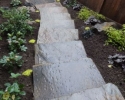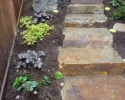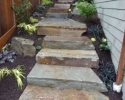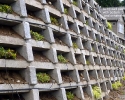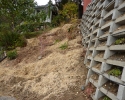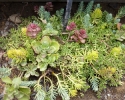On our way down to the camp fire in the Whitehall Woods we talked about deciduous trees like a Big Leaf Maple and Alder; and evergreen trees like Douglas Fir and Western Red Cedar. We identified stinging nettles and what to do if you happen to brush up against them. We used sword ferns as eagle wings and flew into the forest. As we descend into the dense canopy we come upon a log that is covered with a mushroom called Turkey Tail. The colors of the rings are shades of brown, gold and white. The scalloped design on the fungus is lovely to look at and surprisingly solid to the touch. We talk about ‘Decomposers’ or things that help break down the organic matter in the forest and how important they are in the cycle of life.
Thanks to the worm bin we have back at school, the kids have already seen another very important decomposer, the earthworm. Later in our walk we encounter another special decomposer, the ‘Banana Slug’. Unlike the brown and black slugs we encounter in our flower gardens and our Veggie Garden, the yellow / green Banana slug only feeds on dead material, not living plants. So this particular slug simply helps break down debris and duff in the forest, it does not destroy living, valuable plants like the all too common garden varieties.
We come to the camp fire we pull out clip boards and let the kids draw for a while. We look up at the vast canopy of the really tall trees that envelope us. We use our ears to hear the birds chattering in the trees, and the rush of water caused by the rapidly moving Whitehall Creek in the valley below us. In this one small area there are many different kinds of moss to look at and touch. We identify trees that have huge holes in them and talk about why they are there. Many types of beetles and bugs are also decomposers who can be found in rotting snags. Woodpeckers and other animals get their protein by feeding on these bugs as they break down the trees while they are still standing! We talk about what other animals might live in this forest. There are many stumps around us that have notches on them from the last logging venture in these woods over a century ago. We talk about the value of trees both as habitat and as a resource and how important it is to find a balance.
After a snack and some fun with bubbles, we continue on our trail and head down an old logging grade that used to have tracks and a donkey engine which hauled the logs out of the woods into Blanchard where there used to be a mill. We identify native ground cover and flowers such as Mahonia, Bleeding Heart, and Trillium. One area is particularly wet and soggy; the plant material changes and the forest dynamics shifts. Skunk cabbage and native Carex grow vigorously here, and many trees have blown down in this area, not so many large trees left standing in this area. We climb on a nurse log which is a large Cedar and has been breaking down for quite some time; it is now host to several Hemlock trees and red Huckleberry. We talk about symbiotic relationships in the forest and how the cycle of life continues. Some plants and animals in nature are uniquely compatible and enable each other to thrive; sometimes things must die so that other things can grow and live.
After a big hike up the steep hill, we were back to the civilized world of cars, chickens and schedules. Everyone checked out the chicken coop, said their goodbyes, piled into their cars and were on their way down the road, back to their busy lives.
